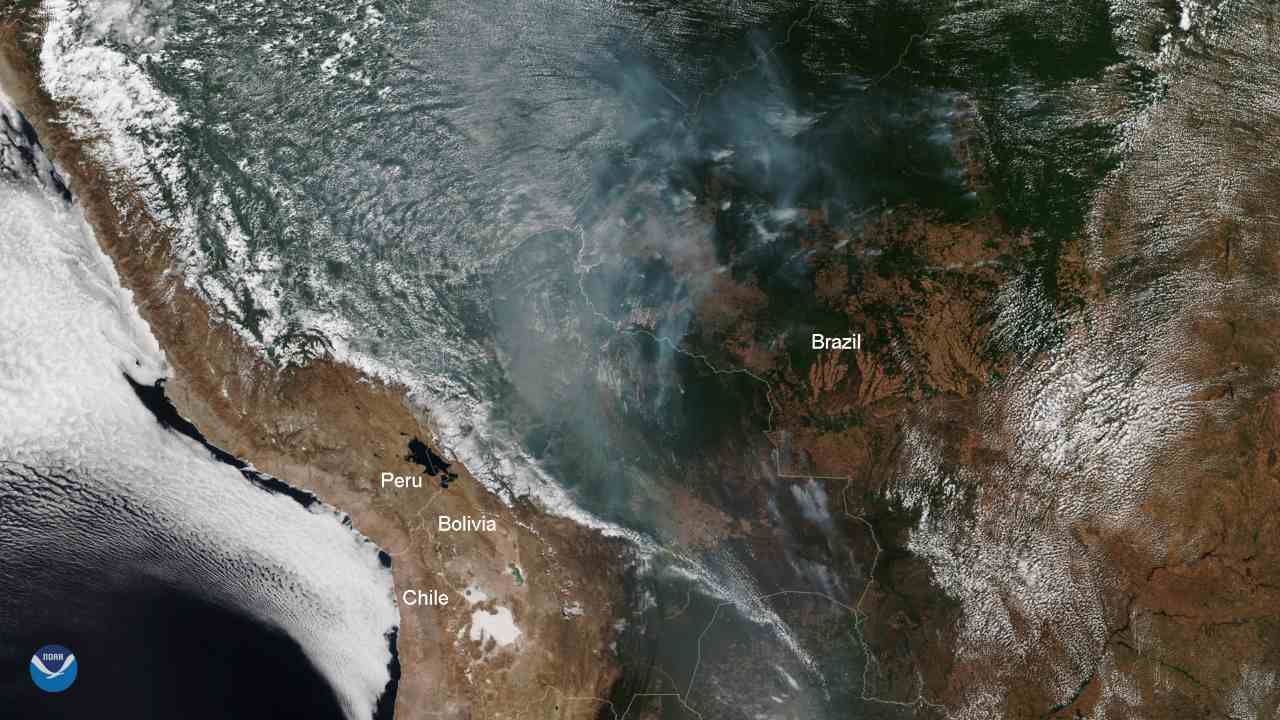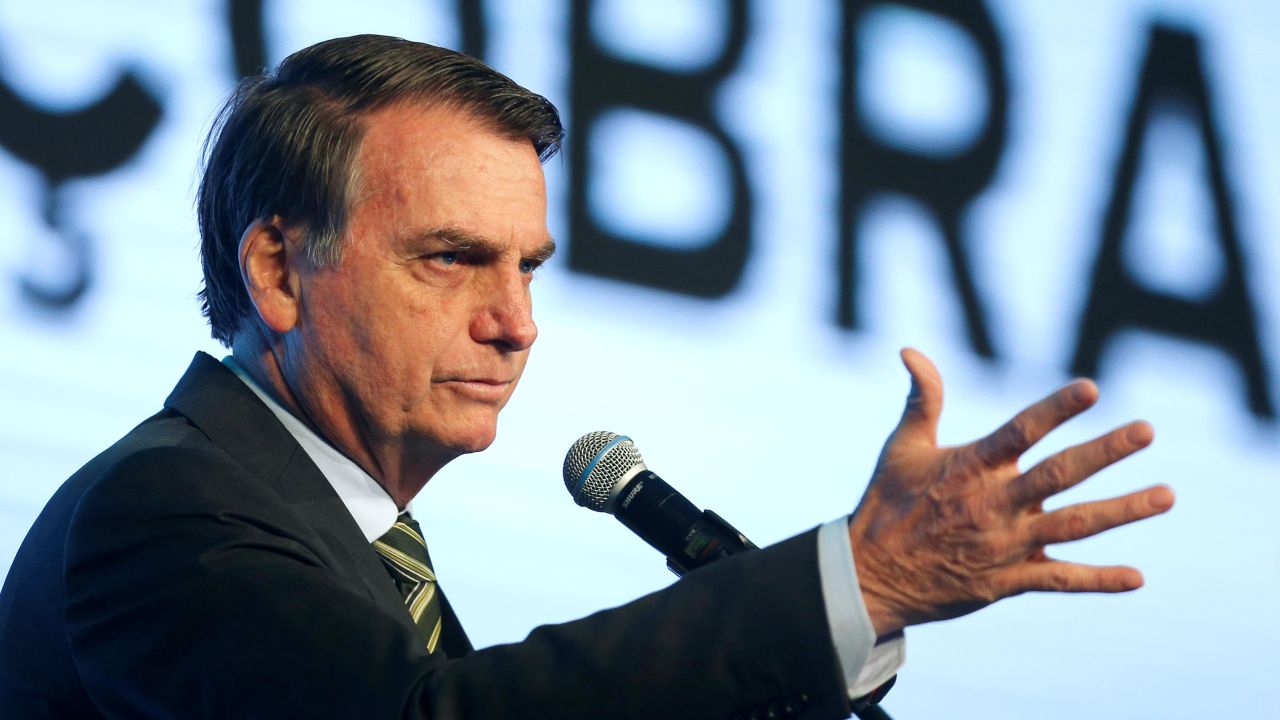"Just a little alert to the world: the sky randomly turned dark today in São Paulo, and meteorologists believe it’s smoke from the fires burning *thousands* of kilometers away, in Rondônia or Paraguay. Imagine how much has to be burning to create that much smoke(!). SOS"
That was a message São Paulo-based journalist Shannon Sims tweeted on 20 August. That was roughly a week after the first news about a surge in forest fires in the Amazon was broken, followed by six continuous days of unrelenting fires in the region. Scientists have declared it a "record rate" of the fire's spread. A warning has since been issued: the burning forest could strike a devastating blow to the global fight against climate change. Potentially, the fires could be something the world doesn't recover from.
Destroyed: 1.5 soccer fields of rainforest per minute
The Amazon region stretches over a 7,000,000 km2 area of river basin. Of this, a 5.5 million square kilometre area spanning nine countries makes up the densest rainforest on Earth. There were an estimated 390 billion trees in the area as of 2013. That number has seen a steep decline over the past few years, particularly under the directives of Brazil's current President. Data from the Brazilian Space Agency shows how Brazil has dramatically reduced deforestation in the Amazon starting at ~2007, reducing it by over 2/3 in half a dozen years and keeping it low for the following decade. That all changed and ecological destruction ensued the Brazilian President's term.
Fires are quite common in the Amazon, with a few ten thousand recorded each year. These fires have increased in frequency of late. A record 72,000 fires have blasted the rainforest since January this year, of which 9,500 are from the past week alone (15 August-21 August), the National Institute for Space Research (INPE) of Brazil has said. This is the highest rate of fires in the region since the country's space research center began tracking them in 2013, the INPE said Tuesday. More than 1½ soccer fields of Amazon rainforest are being destroyed every minute of every day, they added.
This 20th August drone photo shows brush fires burn in Guaranta do Norte municipality, Mato Grosso state in Brazil. Image: AP
Ironically, the Amazon rainforest has been “fire-resistant” for much of its history. This, simply because of the kind of forest it is, receiving rain and staying moist through most of the year. That said, it does also go through hot spells, the US National Oceanic and Atmospheric Administration (NOAA) said, and drought is an established fuel for wildfires. There is nothing abnormal about the climate or rainfall amounts in the Amazon this year, INPE researchers have said.
Environmental groups in Brazil have been campaigning for years to save the rainforest. More recently, they have blamed President Bolsonaro for having endangered the vital rainforest by relaxing restrictions and "openly encouraging deforestation". The Institute of Environmental Research in Amazonia (IPAM) said that it found no evidence to suggest that a lack of rain could have caused the fires, and that deforestation was the primary driver for the fire's reach.
"The dry season creates favourable conditions for the use and spread of fire, but starting a fire is the work of humans, either deliberately or by accident,” INPE researcher Alberto Setzer told Reuters. "The fire that we’re seeing today is a fire that’s directly related to deforestation," said Ane Alencar, scientific director of IPAM.
Research has shown that indigenous management of forests, which has shrunk dramatically in Amazonia since Bolsonaro took office, is the best approach to maintain the health of rainforests, anywhere in the world. In Brazil, which is home to two-thirds of the rainforest, the President, Jair Bolsonaro, has likened indigenous Amazonian reserves to "chickenpox" on the land.
To top it off, an invasion of human activity — farming, mining, and drilling — are exacerbating what was a bad situation to begin with in Brazil. Fears surrounding deforestation continue have grown under Bolsonaro, who appears to be blatantly ignoring international concerns over deforestation and climate change.
The 'Planet's Lungs' are burning
The Amazon rainforest is often referred to as the planet's lungs for producing 20 percent of atmospheric oxygen on the Earth. At roughly two and a half times the size of India, is the largest rainforest on the planet, and home to uncountable species of fauna and flora. It's no surprise that Amazonia is among the most important and vital ecosystems int the world to slow global warming.
The majority – over two-thirds – of the rainforest falls in Brazil, where there have been a total of 72,843 fires this year. Over half of these have been in the Amazon region, according to the INPE – an 80+ percent increase compared to the same period last year. While that sounds like an inordinate number of fires for any single region, here's some perspective: Last year, this same region saw 40,136 fires burn. The second-worst year on record after 2019 was 2016, over which 68,484 fires.
Tropical rainforests everywhere in the world are critical in the fight against climate change. They are large-scale sites that store carbon dioxide, keeping the greenhouse gas in its solid carbon state as soil, branches, and leaves. The Amazon is the world’s largest such tropical rainforest, making its protection critical to the world in its attempts to preventing any further global heating.
The Amazon is also the single-richest biodiversity hotspot – home to the most biodiverse place on Earth. It's safe to say that preserving the rainforest is a matter of slowing down plant and animal extinctions overall.
Widespread devastation & impact
As the fires mark what the world hopes is a climax to the relentless ecological destruction in Brazil over recent years, a Twitter user offers a glimpse of how bad things are at the edges of the fireline in the Amazon as of 20 August this week.
Around 2000 km Southeast of the forest is São Paulo, Brazil, where smoke from the burning forest has created chaos.
São Paulo was blanketed by a layer of thick smoke and ash, as seen in images shared by residents on Twitter. On Monday, 19 August, parts of the city were shrouded in complete darkness between 3 and 4 pm in the afternoon local time.
Residents collected rainwater the other day when the sky had turned dark. This is what it looked like, & they say it smelled like smoke.

Fires in the Amazon Rainforest region as seen by the NOAA-20 satellite. Image: NOAA
Does the President's have a role in it all?
Unlike most other ecosystems, wildfires raging in the Amazon are unnatural, scientists think. The recent surge in deforestation rates in the region is considered a major contributing factor behind the alarming numbers. Environmentalists have pinned the blame on the country's President Jair Bolsonaro, calling out policy after policy directed by the President that have threatened the forest more than it already is.
Bolsonaro has taken a controversial pro-business stance ever since he rolled into office on 1 January, making several promises. Among them were actions to restore Brazil's economy by finding other uses for the Amazon forest. He vowed that if elected, he would not set aside a "single centimetre" more land for indigenous reserves.

President Jair Bolsonaro of the controversial fame for deforestation in Brazil. Image: Reuters
He has expressed disdain for conserving the rainforest, favoring industrial growth relentlessly. Emboldened loggers, farmers, miners, ranchers and other developers have flocked the Amazon brazenly in response, logging at undeveloped forest land, the bulk of which is indigenous territory. The nation's environmental enforcement agency has had its budgets slashed by $23 million, according to a CNN report.
Adding insult to injury, Bolsonaro went ahead and called the recent wave of fires in the Amazon the handiwork of local environmental NGOs.
"Crime exists, and we need to make sure that this type of crime does not increase. We took money away from the NGOs. They are now feeling the pinch from the lack of funding," he said. So, maybe the NGO-types are conducting these criminal acts in order to generate negative attention against me and against the Brazilian government. This is the war we are facing."
Organizations like Greenpeace and World Wildlife Fund have warned that if the Amazon reaches a point of no return, the rainforest could become a dry savannah, no longer habitable, let alone remain vital and biodiverse. The forest could become a large-scale carbon-emitter, where it was once a carbon sink, becoming a powerful driver of climate change.
Find our entire collection of stories, in-depth analysis, live updates, videos & more on Chandrayaan 2 Moon Mission on our dedicated #Chandrayaan2TheMoon domain.
Comments
Post a Comment